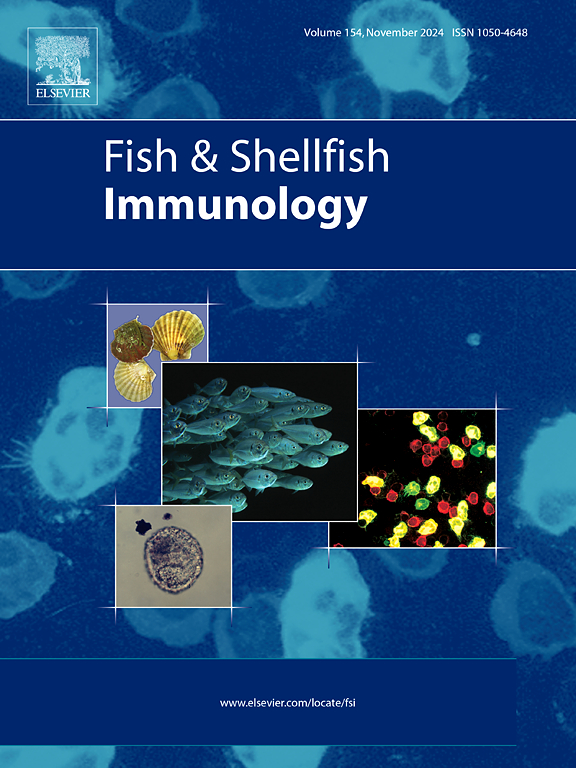急性热应激对大马哈鱼免疫系统的影响及其抵抗鳗弧菌感染和死亡的能力。
IF 3.9
2区 农林科学
Q1 FISHERIES
引用次数: 0
摘要
预计未来几年,加拿大西部热浪的频率、持续时间和强度都将上升,因此,浅水溪流也将经历剧烈的温度波动。这给鲑鱼带来了一个问题,因为遇到高水温可能会增加它们对传染病的易感性。采用环境适用模拟热休克法对大马哈鱼幼鱼进行热休克试验,测定其免疫应答。在热休克后,奇努克鲑鱼也接受了活的鳗弧菌注射,以确定热量是否使它们对全身细菌感染的免疫功能受损。用qPCR方法定量脾脏、鳃和后肠中的il - 1b、il - 8、tnfa、il - 10、tgfb、hsp47、hsp70和hsp90转录本。与对照组相比,热休克对弧菌病的死亡率没有影响。此外,热休克通过最初上调il1b、tnfa、il8和il10,然后在感染后3天恢复到控制水平,减轻了对抗感染所需的促炎和抗炎反应。hsp47和hsp90转录本在热休克和鳗疫病毒的作用下均上调。这项研究报告了血浆中奇努克鲑鱼HSP47蛋白的首次测量,在任何治疗组之间都没有差异。血浆皮质醇和乳酸浓度显著升高,然后在热休克后6小时恢复到基础水平。综上所述,这些数据表明实验性热休克对奇努克鲑鱼具有积极的预处理作用,并为宿主、环境和病原体在14天内的相互作用提供了新的见解。本文章由计算机程序翻译,如有差异,请以英文原文为准。
The effect of acute heat stress on the Chinook salmon immune system and their ability to combat Vibrio anguillarum infection and mortality
The frequency, duration, and intensity of heatwaves in western Canada is expected to rise in the coming years, and as a result, shallow streams will also experience drastic temperature fluctuations. This poses a problem for salmonids as encountering high water temperatures may increase their susceptibility to infectious disease. An environmentally applicable mock heat shock was performed on juvenile Chinook salmon and their immunological responses were measured for 14 days afterwards. Chinook salmon also received an injection of live Vibrio anguillarum after heat shock to determine if heat rendered them immunocompromised to systemic bacterial infection. il1b, il8, tnfa, il10, tgfb, hsp47, hsp70, and hsp90 transcripts were quantified by qPCR in the spleen, gills, and hindgut. Heat shock did not affect mortality rates due to vibriosis compared to controls. Additionally, heat shock mitigated the pro-inflammatory and anti-inflammatory responses needed to combat infection by initially upregulating il1b, tnfa, il8, and il10, then returning to control levels by three days post-infection. Transcripts of hsp47 and hsp90 were upregulated in response to both heat shock and V. anguillarum. This research reports the first HSP47 protein measurements in Chinook salmon in plasma, which did not differ between any treatment groups. Plasma cortisol and lactate concentrations significantly increased, then returned to basal levels 6-h post-heat shock. Altogether, these data indicate that the experimental heat shock had a positive preconditioning effect on Chinook salmon and provides new insights on the interactions between the host, environment, and pathogen over a 14-day period.
求助全文
通过发布文献求助,成功后即可免费获取论文全文。
去求助
来源期刊

Fish & shellfish immunology
农林科学-海洋与淡水生物学
CiteScore
7.50
自引率
19.10%
发文量
750
审稿时长
68 days
期刊介绍:
Fish and Shellfish Immunology rapidly publishes high-quality, peer-refereed contributions in the expanding fields of fish and shellfish immunology. It presents studies on the basic mechanisms of both the specific and non-specific defense systems, the cells, tissues, and humoral factors involved, their dependence on environmental and intrinsic factors, response to pathogens, response to vaccination, and applied studies on the development of specific vaccines for use in the aquaculture industry.
 求助内容:
求助内容: 应助结果提醒方式:
应助结果提醒方式:


